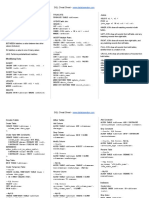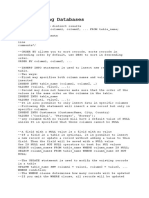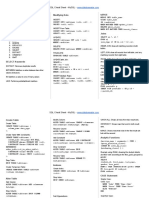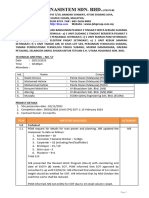0% found this document useful (0 votes)
33 views10 pagesSQL Cheatsheet - Cheat Sheets - OneCompiler
This SQL cheatsheet provides essential commands for creating, inserting, selecting, updating, and deleting data in SQL databases. It covers various SQL operations including joins, constraints, and data control language commands for managing user access. The document serves as a quick reference for common SQL syntax and usage examples.
Uploaded by
pipedir206Copyright
© © All Rights Reserved
We take content rights seriously. If you suspect this is your content, claim it here.
Available Formats
Download as PDF, TXT or read online on Scribd
0% found this document useful (0 votes)
33 views10 pagesSQL Cheatsheet - Cheat Sheets - OneCompiler
This SQL cheatsheet provides essential commands for creating, inserting, selecting, updating, and deleting data in SQL databases. It covers various SQL operations including joins, constraints, and data control language commands for managing user access. The document serves as a quick reference for common SQL syntax and usage examples.
Uploaded by
pipedir206Copyright
© © All Rights Reserved
We take content rights seriously. If you suspect this is your content, claim it here.
Available Formats
Download as PDF, TXT or read online on Scribd
/ 10





















































































